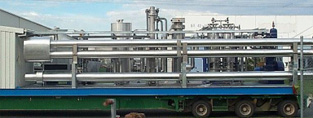
- (03) 5909 8218
- enquiry@fusionweld.com.au
Secondary Functions of Oil and Gas Separators
March 27, 2017

Last time around, we covered the primary functions of these system-essential separators. They're designed to split crude oil discharge, to send liquid oil down one channel and a clean stream of gas down a second line. That's a fairly accurate but simplified description of a two-phase hydrocarbon separation system. What about the secondary functions of oil and gas separators? They undoubtedly exist, so they need to be investigated.
Large Vessel Dynamics
The initial fluid separation process involves a series of specially mounted internal baffles. These inner workings use diverter inlets to alter the momentum of the primary stream. The bulk of the processing load separates here, with other baffle plates supporting fluid isolation mechanics. As for the secondary functions of the oil and gas separators, they're rooted in the buffering capabilities of this large vessel. Held at great pressure, the separate fluid channels employ a gas backpressure valve as the force regulating mechanism. With this valve and a number of subsidiary pressure monitors in place, the banks of baffled and buffered containers pass the segregated fluids across to a gravity separation chamber.
Secondary Gravity Separation Stages
This optimised pressure regulation feature is a secondary function of oil and gas separators, but that subordinate ranking shouldn't deemphasize the importance of this system asset. Indeed, the ability to precisely manage vessel pressure is an essential part of the design because it improves separation dynamics. The gravity splitting segment of the chamber improves its discharge when this important variable submits to process management control. Likewise, the mist extractor section performs with greater efficiency because the density of the fine droplets is regulated by pressure. All of these performance attributes submit to the secondary separation system that's created by the master gas backpressure valve.
Deliquidizers and Degassers
Occupational terminology brings these two labels into the secondary systems maintenance realm. Baffles plates and expertly formed vessels shape the primary process. There are vertically mounted vessels, spherical variants, and horizontal vessels out there, plus numerous baffle plate designs. Deeper in, further into the separator chamber, there's a de-liquidizer assembly, a series of inner workings that are on hand to remove invisible droplets from the gas stream. Conversely, the degassers filter suspended gas bubbles from the liquid as it pools in the vessel.
Pressure regulation lies at the core of the secondary control system. There are baffles, gravity separation systems, mist sprayers, vortex units, and more inside the vessel, but this process subsidising mechanism, the valves and intermediate controls, are working alongside the primary equipment to refine the separation procedure, to really create an absolutely segregated two or three stream discharge.
Contact Details
Fusion - Weld Engineering Pty Ltd
ABN 98 068 987619
1865 Frankston Flinders Road,
Hastings, VIC 3915
Ph: (03) 5909 8218
Optimized by NetwizardSEO.com.au
Recent Posts
- Heat Exchanger Maintenance in Melbourne: Minimising Risk in Power Generation Facilities
- Compressed Hydrogen Storage Vessels: Material Selection, Design & Australian Standards
- Welding QA/QC in Oil & Gas Pressure Vessel Fabrication – Ensuring Code Compliance
- AS1210 vs ASME VIII Pressure Vessel Code: Key Differences for Australian Projects
- Mitigating Hydrogen-Induced Cracking in Pressure Vessels: Engineering and Material Strategies
- Storage Tank Solutions Australia: Field-Erected, Prefabricated & Self-Bunded Explained
- Reducing Environmental Risks: Self-Bunded Tanks in Australian Oil & Gas Operations
- Precision in Production: How Pressure Vessels Are Manufactured for Industrial Safety
- Shell & Tube Heat Exchangers: Improve Thermal Control & Energy Recovery in Petrochemical & Pharmaceutical Plants
- In-Service Inspection for Compressed Air Receivers for Power Plant Shutdown Prevention
- Power Plant Pipe Spooling Fabrication – Get Rapid, Code-Compliant Spools Ready for Installation
- Field Erected Tanks: Safe, Reliable On-Site Fuel Storage Solutions in Australia
Posts 2026
- Heat Exchanger Maintenance in Melbourne: Minimising Risk in Power Generation Facilities
- View all articles…
Posts 2025
- Compressed Hydrogen Storage Vessels: Material Selection, Design & Australian Standards
- Welding QA/QC in Oil & Gas Pressure Vessel Fabrication – Ensuring Code Compliance
- View all articles…
Posts 2024
- Large Process Vessels: Optimising the Design for Maximum Efficiency [2025]
- Pressure Equipment Management System Installation: Detect Equipment Faults Early
- View all articles…
Posts 2023
- Pressure Piping System Inspection: A Gift of Safety for the Holidays
- Deaerator Inspections by Fusion-Weld Engineering and How They Reduce System Downtime
- View all articles…
Posts 2022
- How Fusion Weld Keeps Up With AS-NZS ISO 9001:2008 Standard
- Boiler Equipment Safety Inspection During the Summer Season
- View all articles…
Posts 2021
- Avoid These Factors and Practices that Contribute to Sealing Damage in Pressure Vessels
- Do's And Don'ts Of Industrial Boiler Inspection And Maintenance From Fusion-Weld
- View all articles…
Posts 2020
- What are the Risks and Hazards Involved in Pressure Vessel Equipment?
- How to Know if Your Pressure Equipment Needs Repair or Replacement?
- View all articles…
Posts 2019
- Factors that Contribute to Pressure Vessel Failure
- Pressure Vessel Regulations in Australia: What are the Mandatory Requirements?
- View all articles…
Posts 2018
- Pros and Cons of Spherical vs. Cylindrical Pressure Vessels
- What are the Different Hazard Levels in Pressure Vessels?
- View all articles…
Posts 2017
- Transportable Pressure Vessels: The Importance of Inspection and Safety Checks
- Fracture Mechanics and Stress Analysis of Cracks in Pressure Vessels
- View all articles…
Posts 2016
Posts 2015
- What Are Deaerators & Feedwater Vessels?
- Precautions and Safety for Compressed Air Receiver Vessels
- View all articles…
Posts 2014
- Demonstrating In-process Inspection Procedures
- Static Grounding Practices and Standards
- View all articles…